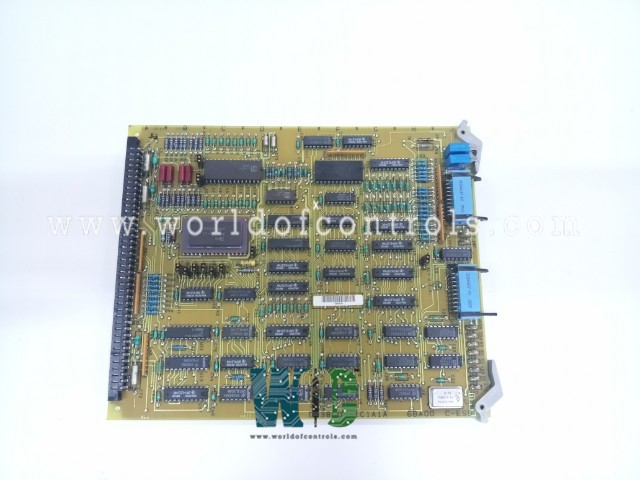
World Of Controls understands the criticality of your requirement and works towards reducing the lead time as much as possible.
DS3800HAIC - Analog Input Board is available in stock which ships the same day.
DS3800HAIC - Analog Input Board comes in UNUSED as well as REBUILT condition.
To avail our best deals for DS3800HAIC - Analog Input Board, contact us and we will get back to you within 24 hours.
SPECIFICATIONS:
Part Number: DS3800HAIC
Manufacturer: General Electric
Series: Mark IV
Product Type: Analog Input Board
Number of channels: 12
Operating temperature: -30 to 65 degrees Celsius
Size: 8.25 cm high x 4.18 cm
Repair: 3-7 Day
Availability: In Stock
Weight: 2 lbs
Country of Origin: United States
FUNCTIONAL DESCRIPTION:
DS3800HAIC is an Analog Input Board manufactured and designed by General Electric as part of the Mark IV Series used in GE Speedtronic Gas Turbine Control Systems. An Analog Input Board is a type of electronic circuit board used to interface analog signals from the physical world with digital systems, such as microcontrollers, computers, or other digital devices. It's designed to convert continuous analog signals into discrete digital values that can be processed by digital systems. Here are some key points about Analog Input Boards:
FEATURES:
Modular Connector: Equipped with a modular connector that allows easy attachment to a drive. It matches the modular connectors located at the back of the rack in the drive. The modular connector provides both power and signal transmission capabilities.
Retention Levers: Includes retention levers that securely hold the board in place within the drive. These levers ensure a stable connection and prevent accidental dislodging.
Jumpers: Populated with 9 jumpers, which are small connectors used to configure or enable/disable specific features or settings on the board. These jumpers provide customization options based on the specific requirements of the system.
Trimmer Resistor Components: Features 2 trimmer resistor components. Trimmer resistors are adjustable resistors that allow fine-tuning of specific electrical parameters. These components help in calibrating or adjusting the board's performance.
20-Pin Connector: Includes a 20-pin connector, which serves as an interface for connecting other components or devices to the board. This connector enables communication and data transfer between the board and external devices.
Test Points: Designated locations for accessing specific signals or measuring voltages. These test points facilitate troubleshooting, debugging, and maintenance tasks by providing convenient access to critical points on the board.
Analog-to-Digital Conversion (ADC): The core function of an Analog Input Board is to perform Analog-to-Digital Conversion (ADC). This process involves sampling the analog signal at discrete time intervals and converting the sampled value into a digital representation. The resolution of the ADC determines how finely the analog signal is quantized.
Voltage Range: Analog Input Boards often have a specified voltage range they can handle. This range defines the minimum and maximum voltage levels that the board can accurately measure. Input signals outside this range might be clipped or distorted.
PRODUCT ATTRIBUTES:
High-Resolution Analog-to-Digital Conversion: Analog input boards typically have high-resolution ADCs that can accurately convert analog signals into digital data with high precision and accuracy.
Signal Conditioning: Analog input boards also have signal conditioning circuits that can filter out noise and interference from the input signals, ensuring that the digital data is as accurate as possible.
High-Speed Sampling: In order to monitor dynamic changes in parameters such as temperature, pressure, and vibration, analog input boards need to be capable of high-speed sampling rates, often in the kilohertz range.
Temperature and Vibration Tolerance: Analog input boards used in turbine control systems need to be able to operate reliably in harsh environments with high temperatures, vibration, and other stresses. Therefore, they are often designed to be highly resistant to these environmental factors.
Modularity and Expandability: Analog input boards can often be modular, allowing for easy expansion and customization of the system. This allows for easy addition or replacement of channels and sensors as needed.
WOC has the largest stock of GE Speedtronic Gas Turbine Control System Replacement Parts. We can also repair your faulty boards. We can also supply unused and rebuilt backed-up with a warranty. Our team of experts is available round the clock to support your OEM needs. Our team of experts at WOC is happy to assist you with any of your automation requirements. For pricing and availability on any parts and repairs, kindly get in touch with our team by phone or email.
What is the purpose of an analog input board in a turbine control system?
An analog input board is used to convert analog signals from sensors and transducers into digital signals that can be processed by a computer or controller in a turbine control system. The board is used to monitor and control various parameters such as temperature, pressure, speed, and vibration.
What are the key features of an analog input board used in turbine control systems?
The key features of an analog input board used in turbine control systems include high-resolution analog-to-digital conversion, signal conditioning, high-speed sampling, wide input range, temperature and vibration tolerance, and modularity and expandability.
How important is accuracy in an analog input board used in turbine control systems?
Accuracy is critical in an analog input board used in turbine control systems, as small inaccuracies or errors in the measurement of critical parameters can have significant impacts on the performance, safety, and reliability of the turbine.